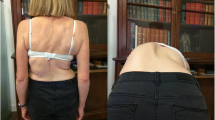Abstract
The aim of the study was to compare the results of brace treatment of adolescent idiopathic scoliosis (AIS) in male patients with matched female patients and to assess the effectiveness of bracing of boys in AIS and to discuss the results with published data. Between 1987 and 1995, 51 consecutive male patients with AIS were treated with the Boston brace. The patients were advised to wear the brace 23 h/day. The medical records of all patients were reviewed. Cobb angles and Risser signs were measured before bracing, in brace, at brace discontinuation and at final follow-up. Everyone of 51 male patients was compared with a female patient who was treated by the same method and matched by Risser sign, curve pattern, curve magnitude and duration of treatment and follow-up time. Compliance with brace was noted at every visit. Fourteen boys had worn the brace only during nighttime or occasionally and were considered non-compliant. Only compliant patients with treatment period > 1 year and follow-up > 1 year after treatment were accepted for the analyses of effectiveness of brace treatment and its prognostic factors. Thirty-three boys met these inclusion criteria. Bracing was considered to have a failure if > 5° progression occurred or if surgery was performed. At the final follow-up study progression > 5° was found in 16/51 (31.4%) of male patients. Corresponding figures of female patients were 11/51 (21.6%), respectively. In compliant boys progression > 5° occurred in 6/33 boys compared with 9/33 girls. The association between risk of progression and correction% in brace was statistically significant. The overall results of brace treatment of idiopathic scoliosis in male patients were inferior compared with matched females. One reason for inferior overall results in boys was poor compliance with brace wear. However, brace treatment in AIS may be recommended with the same principles in both genders.

Similar content being viewed by others
References
Bassett GS, Bunnell WP, MacEwen GD (1986) Treatment of idiopathic scoliosis with the Wilmington brace. Results in patients with a twenty- to thirty-nine-degree curve. J Bone Joint Surg 68A:602–605
Carr WA, Moe JH, Winter RB, Lonstein JE (1980) Treatment of idiopathic scoliosis in the Milwaukee brace. J Bone Joint Surg Am 62:599–612
Emans JB, Kaelin A, Bancel P, Hall JE; Miller ME (1986) The Boston bracing system for idiopathic scoliosis. Follow-up results in 295 patients. Spine 11:792–801
Focarile FA, Bonaldi A, Giarolo M-A, Ferrari U, Zilioli E, Ottaviani C (1991) Effectiveness of nonsurgical treatment for idiopathic scoliosis. Overview of available evidence. Spine 16:395–401
Goldberg CJ, Moore DP, Fogarty EE, Dowling FE (2001) Adolescent idiopathic scoliosis: the effect of brace treatment and the incidence of surgery. Spine 26:42–47
Helenius I, Remes V, Yrjönen T, Ylikoski M, Schlenzka D, Helenius M, Poussa M. (2005). Does gender affect outcome of surgery in adolescent idiopathic scoliosis. Spine 30:462–467
Houghton GR, McInerney A, Tew A (1997) Brace compliance in adolescent idiopathic scoliosis. J Bone Joint Surg Br 69:852
Karol LA (2001) Effectiveness of bracing in male patients with idiopathic scoliosis. Spine 26:2001–2005
Karol LA, Johnston CE, Brownw RH et al (1993) Progression of the curve in boys who have idiopathic scoliosis. J Bone Joint Surg Am 75:1804–1810
Katz DE, Richards BS, Browne RH et al (1997) A comparison between the Boston brace and the Charleston bending brace in adolescent idiopathic scoliosis. Spine 22:1302–1312
Lonstein JE, Carlson JM (1984) The prediction of curve progression in untreated idiopathic scoliosis during growth. J Bone Joint Surg 66A:1061–1071
Lonstein JE, Winter RB (1994) The Milwaukee brace for the treatment of adolescent idiopathic scoliosis: a review of one thousand and twenty patients. J Bone Joint Surg Am 76:1207–1221
Mellin G, Harkonen H, Poussa M (1988) Spinal mobility and posture and their correlations with growth velocity in structurally normal boys and girls aged 13 to 14. Spine 13(2):152–154
Nachemson A, Lonstein JE, Weinstein ST (1982) Prevalence and natural history commitee report. Read at the Annual Meeting of the Scoliosis Research Society, Denver, Colorado, Sept 25
Nachemson AL, Peterson LE (1995) Effectiveness of treatment with a brace in girls who have adolescent idiopathic scoliosis: a prospective, controlled study based on data from the Brace Study of the Scoliosis Research Society. J Bone Joint Surg Am 77:815–821
Noonan KJ, Weinstein SL, Jacobson WC, et al (1996) Use of the Milwaukee brace for progressive idiopathic scoliosis. J Bone Joint Surg Am 78:557–567
Olafsson Y, Saraste H, Söderlund V, Hoffsten M (1995) Boston brace in the treatment of idiopathic scoliosis. J Pediatr Orthop 15:524–527
Peltonen J, Poussa M, Ylikoski M (1988) Three-year results of bracing in scoliosis. Acta Orthop Scand 59:487–490
Peterson LE, Nachemson AL (1995) Prediction of progression of the curve in girls who have adolescent idiopathic scoliosis of moderate severity; logistic regression analysis based on the data from the Brace Study of the Scoliosis Research Society. J Bone Joint Surg Am 77:823–827
Poussa M, Harkonen H, Mellin G (1989) Spinal mobility in adolescent girls with idiopathic scoliosis and structurally normal controls. Spine 14(2):217–219
Rowe DE, Bernstein SM, Riddick MF et al (1997) A meta-analysis of the efficacy of non-operative treatment for idiopathic scoliosis: J Bone Joint Surg Am 79:664–674
Sucato DJ, Hedequist D, Karol LA (2004) Operative correction of adolescent idiopathic scoliosis in male patients. J Bone Joint Surg Am 86:2005–2014
Takemitsu M, Bowen R, Rahman T, Glutting J, Scott C (2004). Compliance monitoring of brace treatment for patients with idiopathic scoliosis. Spine 29:2070–2074
Author information
Authors and Affiliations
Corresponding author
Rights and permissions
About this article
Cite this article
Yrjönen, T., Ylikoski, M., Schlenzka, D. et al. Results of brace treatment of adolescent idiopathic scoliosis in boys compared with girls: a retrospective study of 102 patients treated with the Boston brace. Eur Spine J 16, 393–397 (2007). https://doi.org/10.1007/s00586-006-0167-z
Received:
Revised:
Accepted:
Published:
Issue Date:
DOI: https://doi.org/10.1007/s00586-006-0167-z



